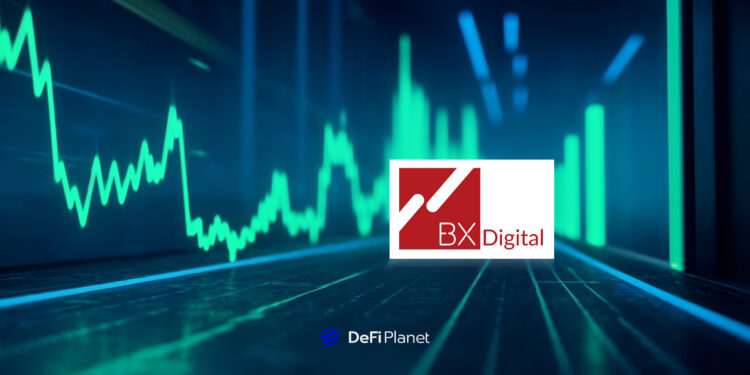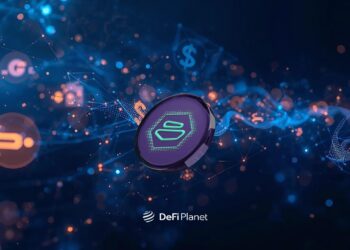Traditional trading systems in European financial markets, like exchanges, clearinghouses, and brokers, have long been the backbone of asset transactions. However, these centralized structures often come with high fees, slow execution times, and limitations in accessibility.
As the financial industry evolves, these inefficiencies have become more noticeable, especially with the growth of digital assets and the increasing demand for faster, more secure blockchain trading solutions.
That’s where BX Digital steps in. With its blockchain trading platform, BX Digital aims to disrupt the status quo by offering a decentralized, more efficient way to trade assets. By leveraging the transparency and speed of blockchain, BX Digital seeks to reduce intermediaries and improve market access for all types of traders.
This review examines how BX Digital could transform the European market, challenge traditional systems, and enhance overall market efficiency. Can BX Digital lead the way in revolutionizing Europe’s financial infrastructure? Let’s dive in.
What Is BX Digital and How Does Its Blockchain-Based Trading System Work?
BX Digital is a blockchain-powered trading platform designed to enhance market efficiency and reduce reliance on intermediaries. By utilising blockchain technology, it offers faster, more secure, and transparent trading, addressing issues like slow execution, high fees, and limited accessibility that exist in traditional financial systems.
BX Digital targets institutional investors, financial professionals, and retail traders who seek fast, low-cost, and secure blockchain trading solutions. It focuses on digital assets like cryptocurrencies and tokenized assets, primarily serving the European market while planning global expansion as blockchain adoption grows.
How BX Digital’s Blockchain-Based Trading System Works
BX Digital operates on a blockchain foundation to improve the way digital assets are traded and settled. Built on the Ethereum blockchain, the platform eliminates traditional intermediaries like clearinghouses and central securities depositories, enabling faster and more cost-efficient transactions.
Trades on BX Digital are executed using smart contracts, automated programs that handle everything from asset transfer to payment once both parties agree. This eliminates the need for trust between buyers and sellers, significantly reducing counterparty risk.
Although BX Digital functions as a centralized exchange in terms of oversight and regulation, it adopts principles from DeFi to bring more transparency, efficiency, and programmability to traditional financial markets.
One of the standout features of the platform is its support for tokenized assets. These digital representations of traditional financial instruments, like stocks or bonds, can be traded directly on the blockchain.
This speeds up transactions and also makes them more secure and traceable. Since settlement and clearing are also done on-chain, the entire process becomes nearly instant, reducing delays and lowering operational costs.
By combining the transparency and automation of blockchain with regulatory compliance, BX Digital presents a forward-looking model for blockchain trading in Europe, streamlining operations while providing the trust and structure necessary for both institutional and retail participation alike.
Key Features of BX Digital’s Platform
BX Digital‘s platform leverages blockchain technology to enhance various aspects of digital asset trading. Here’s an overview of its key features:
Speed and Efficiency
By utilizing the Ethereum blockchain, BX Digital enables direct settlement and transfer of assets without intermediaries like central securities depositories. This approach reduces transaction times and operational costs, facilitating faster and more efficient blockchain trading of tokenized assets such as shares, bonds, and funds among financial institutions.
Transparency and Security
The platform employs smart contracts to automate trade execution and settlement, ensuring transparency and reducing the risk of counterparty default. Additionally, BX Digital integrates Chainlink’s decentralized oracle network to provide secure and verifiable on-chain market data, enhancing the reliability of pricing information.
Cost Reduction
By eliminating intermediaries, BX Digital lowers transaction fees and operational overhead. The direct connection between trading participants’ wallets allows for cost-effective asset transfers, providing greater control over digital assets.
Liquidity
BX Digital fosters a liquid market for digital assets by supporting the trading of tokenized securities on a regulated secondary market. This approach attracts a vast network of market participants, creating new investment opportunities and enhancing market liquidity.
Compliance and Regulation
As the first institution in Switzerland authorized by FINMA to operate a DLT trading facility, BX Digital adheres to stringent regulatory standards. The platform’s compliance with regulations such as MiFID II and GDPR ensures investor protection and legal certainty in digital asset trading.
User Experience
BX Digital offers a user-friendly interface specifically designed for traders, investors, and institutional clients. The platform offers tools for efficient trading, settlement, and communication with investors, providing a seamless experience within the digital asset ecosystem.
Impact on Market Efficiency
BX Digital‘s blockchain-based trading platform is poised to enhance market efficiency in the European financial sector significantly. Here’s how:
Reduced Friction in Trading
By eliminating traditional intermediaries such as central securities depositories, BX Digital streamlines the trading process. Utilizing smart contracts on the Ethereum blockchain, the platform automates trade execution and settlement, reducing operational bottlenecks and simplifying trade lifecycles.
Faster Settlement Times
Traditional markets often operate on a T+2 settlement cycle, meaning transactions settle two days after the trade date. BX Digital offers near-instantaneous settlement through its blockchain infrastructure, enabling quicker capital turnover and reducing counterparty risk.
Greater Transparency
All transactions on BX Digital are recorded on an immutable, decentralized ledger, providing real-time access to transaction data. This transparency enhances market behaviour and facilitates regulatory oversight by offering an auditable trail of all trading activities.
Lower Operational Overhead
The platform’s decentralized architecture and use of smart contracts reduce the need for multiple legacy systems. This streamlining of workflows leads to lower operational costs and increased efficiency in back-office processes.
Improved Market Liquidity
BX Digital promotes liquidity through the tokenization of assets, allowing for fractional ownership and 24/7 market access. This approach creates deeper and more dynamic liquidity pools compared to traditional setups, facilitating easier access to capital for a broader range of market participants.
How BX Digital Compares with Traditional Trading Systems in Europe
Here’s how BX Digital compares with traditional trading systems in Europe:
Aspect | BX Digital | Traditional Trading Systems |
| Trading Model | Decentralized, peer-to-peer blockchain-based model | Centralized, with intermediaries such as brokers, exchanges, and clearing houses |
| Regulatory Environment | Compliance-focused, adapts to regulatory frameworks like MiCA and GDPR | Strictly regulated by national financial authorities (e.g., FCA in the UK, BaFin in Germany) |
| Transaction Speed | Fast, with near-instant transactions using blockchain protocols | Relatively slower, due to intermediaries and settlement times in traditional financial systems |
| Market Accessibility | Global access to trading for users without geographical or institutional barriers | Limited by geography, national regulations, and access to financial institutions |
| Security and Transparency | Blockchain offers high levels of security and transparency with verifiable transaction records | Security depends on centralized institutions, vulnerable to breaches or system failures |
| Cost structure | Lower transaction fees and no intermediary costs due to decentralization | Higher fees, including broker fees, exchange fees, and transaction costs |
| Asset Types | Supports tokenized assets, including cryptocurrencies, real estate, and other blockchain-native assets | Focuses on conventional financial products like stocks, bonds, ETFs, and commodities |
| Liquidity | Liquidity can vary depending on network activity, with decentralized exchanges providing a dynamic market | High liquidity through well-established exchanges and institutional market makers |
| User Control | Full control over assets without reliance on a central authority | Control of assets is entrusted to brokers and custodians |
| Innovation and Flexibility | Highly innovative, with the ability to quickly adapt and introduce new financial products like DeFi | Slower to innovate due to legacy infrastructure and regulations |
Challenges and Risks
While BX Digital offers various benefits, there are several challenges and criticisms that could hinder its long-term success and mainstream adoption.
Challenges and Risks
- Regulatory Uncertainty
- Adoption Barriers
- Scalability Issues
- Security Risks
- Interoperability
- Market Liquidity
Regulatory Uncertainty
BX Digital faces challenges with Europe’s evolving regulations. Authorities are still working on rules like MiCA (Markets in Crypto-Assets) and GDPR, which may create uncertainties for decentralized platforms.
BX Digital could struggle to comply with these regulations, causing delays or adoption barriers. The lack of unified regulations across Europe could create legal obstacles for its growth.
Adoption Barriers
Traditional financial institutions, traders, and market participants may resist adopting BX Digital’s decentralized model. These groups are used to centralized systems and may have concerns about blockchain’s volatility and regulatory uncertainties.
Additionally, the complexity of blockchain technology might make it harder for them to move away from systems they trust. Gaining their confidence will be crucial for BX Digital‘s widespread adoption.
Scalability Issues
Blockchain technology, while powerful, still faces scalability challenges. As BX Digital grows and sees more transactions, the system could slow down or become more expensive. The platform may struggle to handle a high volume of transactions, leading to bottlenecks.
To address this, BX Digital may need to implement scaling solutions, such as Layer 2 protocols, but this will require technical expertise and resources.
Security Risks
While blockchain is generally secure, it still poses certain risks. Smart contracts and decentralized apps (dApps) can have vulnerabilities if they aren’t properly designed or audited.
There’s also the risk of hacking or fraud, which could result in lost funds or damage to BX Digital’s reputation. To prevent these issues, BX Digital will need to ensure strict security measures, conduct regular audits, and stay ahead of potential risks.
Interoperability
BX Digital will need to integrate smoothly with traditional financial systems (e.g., banks) and other blockchain platforms. However, legacy systems often employ different technologies, which can make this integration challenging.
Ensuring BX Digital works well with both centralized systems and decentralized platforms is key for a seamless user experience and attracting a wide range of users.
Market Liquidity
Attracting enough liquidity in the early stages could be a challenge for BX Digital. New platforms often struggle to convince traders to move large amounts of money, especially when established players dominate the market.
BX Digital will need to build strong partnerships, attract institutional investors, and develop a trusted user base to increase liquidity as the platform expands.
Is BX Digital a True Game-Changer?
BX Digital has the potential to disrupt the European market; however, its success depends on overcoming challenges such as regulatory uncertainty and resistance from traditional financial institutions.
If it can address these issues, BX Digital could transform financial transactions by offering lower fees, greater transparency, and better accessibility. With growing interest in blockchain and DeFi, BX Digital is well-positioned to tap into an expanding market, provided it resolves scalability and security concerns.
Moving forward, BX Digital’s success will rely on building strong partnerships, gaining regulatory approval, and attracting liquidity. If BX Digital can integrate with existing systems and earn trust from both institutional and retail users, it could become a game-changer in the financial industry, promoting a more decentralized, efficient, and accessible blockchain trading environment.
Disclaimer: This article is intended solely for informational purposes and should not be considered trading or investment advice. Nothing herein should be construed as financial, legal, or tax advice. Trading or investing in cryptocurrencies carries a considerable risk of financial loss. Always conduct due diligence.
If you would like to read more articles like this, visit DeFi Planet and follow us on Twitter, LinkedIn, Facebook, Instagram, and CoinMarketCap Community.
Take control of your crypto portfolio with MARKETS PRO, DeFi Planet’s suite of analytics tools.”





















